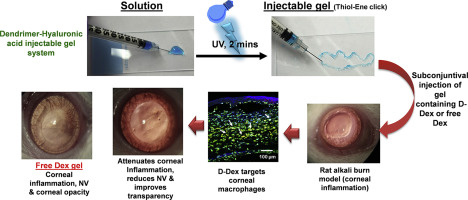当前位置:
X-MOL 学术
›
Biomaterials
›
论文详情
Our official English website, www.x-mol.net, welcomes your
feedback! (Note: you will need to create a separate account there.)
Subconjunctival injectable dendrimer-dexamethasone gel for the treatment of corneal inflammation
Biomaterials ( IF 12.8 ) Pub Date : 2017-03-22 03:27:48 Uri Soiberman, Siva P. Kambhampati, Tony Wu, Manoj K. Mishra, Yumin Oh, Rishi Sharma, Jiangxia Wang, Abdul Elah Al Towerki, Samuel Yiu, Walter J. Stark, Rangaramanujam M. Kannan
Biomaterials ( IF 12.8 ) Pub Date : 2017-03-22 03:27:48 Uri Soiberman, Siva P. Kambhampati, Tony Wu, Manoj K. Mishra, Yumin Oh, Rishi Sharma, Jiangxia Wang, Abdul Elah Al Towerki, Samuel Yiu, Walter J. Stark, Rangaramanujam M. Kannan

|
Corneal inflammation is often encountered as a key pathological event in many corneal diseases. Current treatments involve topical corticosteroids which require frequent instillations due to rapid tear turnover, causing side-effects such as corneal toxicity and elevated intraocular pressure (IOP). Hence, new interventions that can reduce side effects, dosing frequency, and increase patient compliance can be highly beneficial. In this study, we explore a subconjunctival injectable gel based on G4-PAMAM dendrimer and hyaluronic acid, cross-linked using thiol-ene click chemistry, incorporated with dendrimer dexamethasone (D-Dex) conjugates as a potential strategy for sustained delivery and enhanced bioavailability of corticosteroids. The efficacy of the injectable gel formulation was evaluated in a rat mild alkali burn model. Fluorescently-labelled dendrimers (D-Cy5) incorporated in the gel release D-Cy5 in vivo. The released D-Cy5 selectively targets and localizes within corneal macrophages in inflamed rat cornea but not in healthy controls. This pathology dependent biodistribution was exploited for drug delivery, by incorporating D-Dex in the injectable gel. The attenuation of corneal inflammation by D-Dex gels was assessed using various clinical and biochemical parameters over a 2-week period. Subconjunctival D-Dex gel treatment resulted in favorable clinically-relevant outcomes with reduced central corneal thickness and improved corneal clarity compared to free-Dex and placebo gel controls. The extent of corneal neovascularization was significantly reduced in the D-Dex group. These findings suggest that D-Dex attenuates corneal inflammation more effectively than free-Dex by attenuating macrophage infiltration and pro-inflammatory cytokines expression. A significant elevation in IOP was not observed in the D-Dex group but was observed in the free-Dex group. This novel injectable D-Dex gel may be a potential drug delivery platform for the treatment of many inflammatory ocular surface disorders such as dry eye, auto-immune keratitis and post-surgical complications where frequent steroid administration is required.
中文翻译:

结膜下注射树状聚合物地塞米松凝胶治疗角膜炎症
在许多角膜疾病中,经常遇到角膜炎症是关键的病理事件。当前的治疗涉及局部皮质类固醇,由于快速的泪液周转需要频繁滴注,引起副作用,例如角膜毒性和眼内压升高(IOP)。因此,可以减少副作用,给药频率并增加患者依从性的新干预措施可能会非常有益。在这项研究中,我们探索了基于G4-PAMAM树状聚合物和透明质酸的结膜下可注射凝胶,使用硫醇-烯点击化学将其交联,并结合树状聚合物地塞米松(D-Dex)缀合物作为持续递送和提高生物利用度的潜在策略皮质类固醇。在大鼠轻度碱烧伤模型中评估了可注射凝胶制剂的功效。掺入凝胶中的荧光标记的树状聚合物(D-Cy5)在体内释放D-Cy5。释放的D-Cy5选择性靶向并定位在发炎的大鼠角膜中的角膜巨噬细胞内,但在健康对照组中则没有。通过将D-Dex掺入可注射的凝胶中,可以利用这种依赖于病理学的生物分布来进行药物输送。在2周的时间内,使用各种临床和生化参数评估了D-Dex凝胶对角膜炎症的缓解作用。与游离Dex和安慰剂凝胶对照相比,结膜下D-Dex凝胶治疗可产生与临床相关的良好结局,中心角膜厚度减小,角膜清晰度提高。D-Dex组的角膜新生血管程度明显降低。这些发现表明,D-Dex通过减弱巨噬细胞浸润和促炎性细胞因子表达,比游离-Dex更有效地减轻了角膜炎症。D-Dex组未观察到IOP明显升高,而游离Dex组则观察到IOP明显升高。这种新型的可注射D-Dex凝胶可能是潜在的药物输送平台,可用于治疗许多炎症性眼表疾病,例如干眼症,自身免疫性角膜炎和需要频繁给予类固醇的手术后并发症。
更新日期:2017-03-22
中文翻译:

结膜下注射树状聚合物地塞米松凝胶治疗角膜炎症
在许多角膜疾病中,经常遇到角膜炎症是关键的病理事件。当前的治疗涉及局部皮质类固醇,由于快速的泪液周转需要频繁滴注,引起副作用,例如角膜毒性和眼内压升高(IOP)。因此,可以减少副作用,给药频率并增加患者依从性的新干预措施可能会非常有益。在这项研究中,我们探索了基于G4-PAMAM树状聚合物和透明质酸的结膜下可注射凝胶,使用硫醇-烯点击化学将其交联,并结合树状聚合物地塞米松(D-Dex)缀合物作为持续递送和提高生物利用度的潜在策略皮质类固醇。在大鼠轻度碱烧伤模型中评估了可注射凝胶制剂的功效。掺入凝胶中的荧光标记的树状聚合物(D-Cy5)在体内释放D-Cy5。释放的D-Cy5选择性靶向并定位在发炎的大鼠角膜中的角膜巨噬细胞内,但在健康对照组中则没有。通过将D-Dex掺入可注射的凝胶中,可以利用这种依赖于病理学的生物分布来进行药物输送。在2周的时间内,使用各种临床和生化参数评估了D-Dex凝胶对角膜炎症的缓解作用。与游离Dex和安慰剂凝胶对照相比,结膜下D-Dex凝胶治疗可产生与临床相关的良好结局,中心角膜厚度减小,角膜清晰度提高。D-Dex组的角膜新生血管程度明显降低。这些发现表明,D-Dex通过减弱巨噬细胞浸润和促炎性细胞因子表达,比游离-Dex更有效地减轻了角膜炎症。D-Dex组未观察到IOP明显升高,而游离Dex组则观察到IOP明显升高。这种新型的可注射D-Dex凝胶可能是潜在的药物输送平台,可用于治疗许多炎症性眼表疾病,例如干眼症,自身免疫性角膜炎和需要频繁给予类固醇的手术后并发症。


















































 京公网安备 11010802027423号
京公网安备 11010802027423号